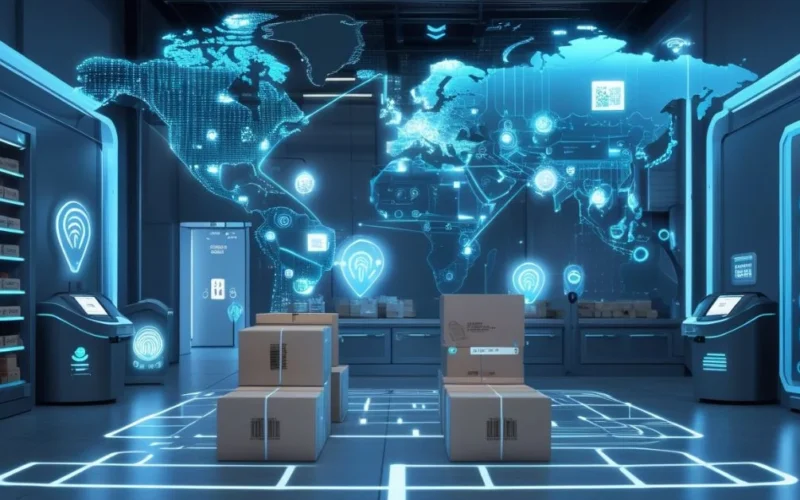Table of Contents
- Automatic Identification Technology in 2025
- Growth of RFID in Business Use
- Barcodes Stay Strong in Global Trade
- Biometric Systems Improve Security
- Smart Labels Add Real-Time Features
- Popular in Food and Pharma
- Automatic Identification in Healthcare
- Retail Becomes Smarter and Faster
- Supply Chain Management Gets Stronger
- How Does It Work in Supply Chains?
- Warehouse Automation with ID Tech
- IoT Connects Everything Seamlessly
- Government and Legal Impact on Growth
- Table: Common Automatic Identification Technologies and Their Uses
- Conclusion
Automatic Identification Technology in 2025
The automatic identification technology market is growing rapidly in 2025, driven by the global need for faster, safer, and more reliable data collection methods. These systems allow businesses to automatically capture, store, and share information with minimal human input. As companies shift to digital systems, tools like RFID (Radio-Frequency Identification), barcodes, biometric verification, and smart sensors are becoming essential in daily operations.
These technologies are widely used in retail, logistics, healthcare, manufacturing, and transportation. They allow for better tracking of inventory, monitoring of supply chains, and identification of individuals or items in real-time. This reduces human error, improves workplace efficiency, and enhances data security.
Growth of RFID in Business Use
Radio-frequency identification (RFID) is one of the most used tools in automatic identification technology. In 2025, RFID systems will be everywhere, from retail and healthcare to supply chains and manufacturing. They help track goods, equipment, and even people.
Key Uses of RFID in 2025
- Inventory tracking in warehouses
- Patient identification in hospitals
- Asset tracking in logistics
- Contactless payment systems
RFID saves time by scanning items instantly without needing line-of-sight. It also reduces loss or theft.
Barcodes Stay Strong in Global Trade

Even with the rise of advanced technologies like RFID and biometrics, barcodes remain highly valuable in 2025. These simple, printed codes are still widely used because they are low-cost, easy to print, and quick to scan. Many businesses prefer barcodes for their affordability and reliability, especially when managing large numbers of items.
Barcodes play an important role in retail for product labeling, in transportation for package tracking, and in healthcare for patient ID and medication management. Despite newer systems entering the market, barcodes continue to deliver results with minimal setup costs. Their long-standing presence and universal compatibility make them a practical choice for businesses of all sizes.
Barcodes in Retail and Supply Chains
- Scan items during checkout
- Manage stock in stores and warehouses
- Track product history and movement
While RFID may seem more advanced, barcodes are still trusted by many due to their simplicity and affordability.
Biometric Systems Improve Security
Biometric identification, like fingerprints, facial recognition, and voice patterns, is widely used in 2025. It helps confirm identity quickly and securely without needing passwords or cards. This tech is now common in phones, airports, offices, and hospitals, offering better security and faster access. Its accuracy and ease make it a trusted tool for preventing fraud and improving safety.
Biometric Tools in Use Today
- Smartphones and laptops with fingerprint access
- Facial scanners at airports and office entrances
- Voice ID in banking systems
Biometric systems reduce the chance of fraud. They are reliable and offer fast access with fewer password issues.
Smart Labels Add Real-Time Features
Smart labels use built-in sensors and tags with software to give real-time data about an item’s location, temperature, and condition. In 2025, they are widely used in food, pharma, and shipping to ensure safety and quality during transport.
Popular in Food and Pharma
- Track food freshness in shipping
- Monitor medicine storage
- Alert if goods overheat or get damaged
Smart labels help ensure safety and quality, especially in sensitive sectors.
Automatic Identification in Healthcare
In 2025, automatic identification technology will be widely used in healthcare to improve patient care and reduce errors. Hospitals now use RFID wristbands, barcode scanners, and digital tracking systems to accurately identify patients, track treatments, and manage medical supplies.
For example, RFID tags help locate equipment quickly, while barcodes on medicine ensure the right drug is given to the right patient at the right time. These systems also record every step of patient care, reducing human error, improving efficiency, and ensuring safety throughout the treatment process. As a result, healthcare becomes more organized, faster, and safer for everyone involved.
Tech That Helps Doctors and Nurses
- Wristbands with patient data
- RFID to find medical tools
- Barcodes on medicine packages
This results in faster service and better safety for patients.
Retail Becomes Smarter and Faster
Retailers use automatic identification in 2025 to speed up shopping, manage stock, and improve customer service. Tools like self-checkout kiosks and smart inventory systems help make shopping faster and more efficient.
Benefits in Retail
- Quick item scanning
- Fewer checkout lines
- Fast restocking alerts
- Real-time sales updates
Retailers can track customer habits and offer better deals, thanks to this tech.
Supply Chain Management Gets Stronger

In 2025, automatic identification will play a key role in supply chain management. It allows companies to track products in real time, from the factory to the customer. Using tools like RFID tags and barcodes, businesses can monitor shipments, check inventory levels, and respond quickly to delays or errors. This helps reduce lost items, late deliveries, and stock shortages, making the entire supply chain faster and more reliable.
How Does It Work in Supply Chains?
- Scan items at each checkpoint
- Get live updates on location
- Monitor delivery status
- Handle returns faster
This visibility builds trust between suppliers and customers.
Warehouse Automation with ID Tech
In 2025, warehouses will rely more on machines than manual labor. Automatic identification tools like RFID, barcodes, and sensors help automate tasks such as tracking, sorting, and storing goods, making operations faster and more accurate.
Smart Warehousing Tools
- Robots using RFID to pick items
- Barcode systems to organize storage
- Drones to scan stock on high shelves
These changes cut costs and speed up delivery processes.
IoT Connects Everything Seamlessly
In 2025, the Internet of Things (IoT) connects devices like sensors, cameras, and ID tags to the internet. This connection allows for real-time tracking and data sharing, making automatic identification systems smarter and more efficient.
Real-Time Communication Across Systems
- Track goods from the factory to the home
- Know when a machine needs repair
- Follow a product’s full history
With IoT, businesses react faster and plan better. It also helps with energy saving and waste control.
Government and Legal Impact on Growth
Regulations now support automatic identification in many places. Governments require safe, secure, and traceable systems in industries like food, transport, and healthcare.
Policies That Boost Adoption
- Food safety rules require smart tracking
- ID standards for medical devices
- Customs using RFID for trade checks
These laws drive companies to use better technology and keep records safe and clear.
Table: Common Automatic Identification Technologies and Their Uses
| Technology | Main Use Area | Benefits |
| RFID | Retail, Logistics, Health | Fast scans, no line-of-sight |
| Barcodes | Retail, Transport | Cheap, easy to print and scan |
| Biometrics | Security, Healthcare | Strong ID, fast access |
| Smart Labels | Food, Pharma | Real-time updates, condition data |
| IoT Devices | All industries | Live tracking, remote updates |
Conclusion
The automatic identification technology market in 2025 is full of smart, fast, and secure solutions. RFID, barcodes, biometrics, and smart sensors are helping businesses work better. From stores and warehouses to hospitals and factories, these tools reduce errors, speed up work, and improve safety. As more industries move toward digital and connected systems, automatic identification will continue to grow and shape the future.








